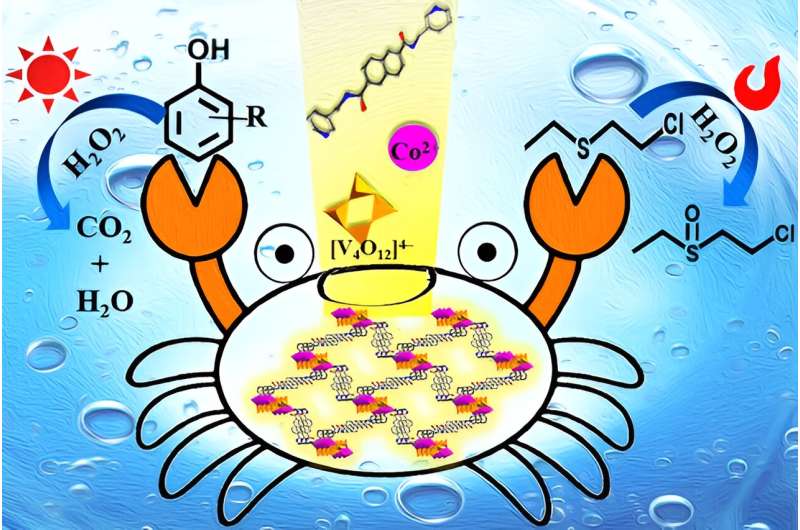This article has been reviewed according to Science X's editorial process and policies. Editors have highlighted the following attributes while ensuring the content's credibility:
fact-checked
proofread
Scientists design bifunctional catalyst to address environmental pollution problems

A team of researchers from Bohai University in China has designed and synthesized a bifunctional catalyst that can solve the environmental pollution caused by mustard gas and phenolic compounds. They synthesized this bifunctional catalyst, a new three-dimensional polyoxovanadate-based metal-organic framework, under hydrothermal conditions.
Their work is published in the journal Polyoxometalates.
The team's bifunctional catalyst shows satisfying catalytic performances for the selective oxidation of 2-chloroethyl ethyl sulfide (CEES) to corresponding sulfoxide (CEESO) and photodegradation toward phenol, CEES, and m-cresol under visible light. A bifunctional catalyst is one that provides both acidic and basic catalytic functions.
In recent years, the problem of organic hazardous substances that cause pollution has raised considerable concern. Scientists have focused their work on developing reasonable methods for degrading these organic hazardous substances. CEES, or mustard gas, is a chemical warfare agent that causes severe skin diseases, strong irritation of the respiratory tract, and even death.
Since mustard gas was first used in World War I, researchers have sought ways to detoxify this chemical warfare agent. M-cresol is an organic compound that is extracted from coal tar and is used in the production of other chemicals, including pesticides. It is corrosive to the eyes, skin, and respiratory tract.
Phenolic pollutants often persist in polluted wastewater that flows from industrial, agricultural, and domestic work. Once they make their way into the water systems, phenolic pollutants can be very harmful to humans and the environment. These pollutants can be acutely toxic to the point of causing the death of animals, birds, or fish.
They can also stunt the growth of or kill plants. Scientists have been working to design by synthesis of new bifunctional catalysts that can convert these types of dangerous pollutants into low-toxicity degradants. However, up to this point in time, scientists had not successfully achieved the preparation of high dimensional interpenetrating metal-organic frameworks that can act as bifunctional catalysts capable of oxidizing CEES to CEESO and degrading phenolic compounds under visible light.
Polyoxometalates (POMs) are a kind of inorganic metal oxide clusters with diverse architectural structures and attractive properties. Because of their wide array of structures and functionalities, they are one of the most useful classes of inorganic molecular materials. Within the POMs family, polyoxovanadates (POVs) have attracted increasing attention from scientists because of their diverse structures and remarkable properties.
The researchers used a bis-pyridyl-bis-amide ligand to construct the new POV-based metal-organic framework. They then studied the 3D POV-based metal-organic framework using single-crystal X-ray diffraction analysis, IR spectroscopy, and powder X-ray diffraction. "The long feature of the amide-based ligand induces the formation of the unusual 2-fold interpenetrating structure," said Guo-Cheng Liu, an associate professor at Bohai University.
The team's bifunctional catalyst successfully catalyzed the selective oxidation of toxic CEES to the corresponding safer sulfoxide in the presence of H2O2, or hydrogen peroxide, as an eco-friendly oxidant. It worked under visible light with effective recyclability and stability. The successful conversion was greater than 99 percent, and the selectivity was 97 percent.
In addition, the bifunctional catalyst showed excellent photocatalytic degradation activity toward phenol, CEES, and m-cresol under visible light. The team successfully achieved degradation efficiencies above 92.6 percent for 140 minutes.
They also investigated in detail the photocatalytic reaction kinetics, the mechanisms of photodegradation, and the recycling capability of phenol. "This work provides important guidance for the development of new POVs-based bifunctional catalysts for decontamination in water," said Liu.
More information: Shuang Li et al, New two fold interpenetrating 3D polyoxovanadate-based metal–organic framework as bifunctional catalyst for the removal of 2-chloroethyl ethyl sulfide and phenolic compounds, Polyoxometalates (2024). DOI: 10.26599/POM.2024.9140061
Provided by Tsinghua University Press





















